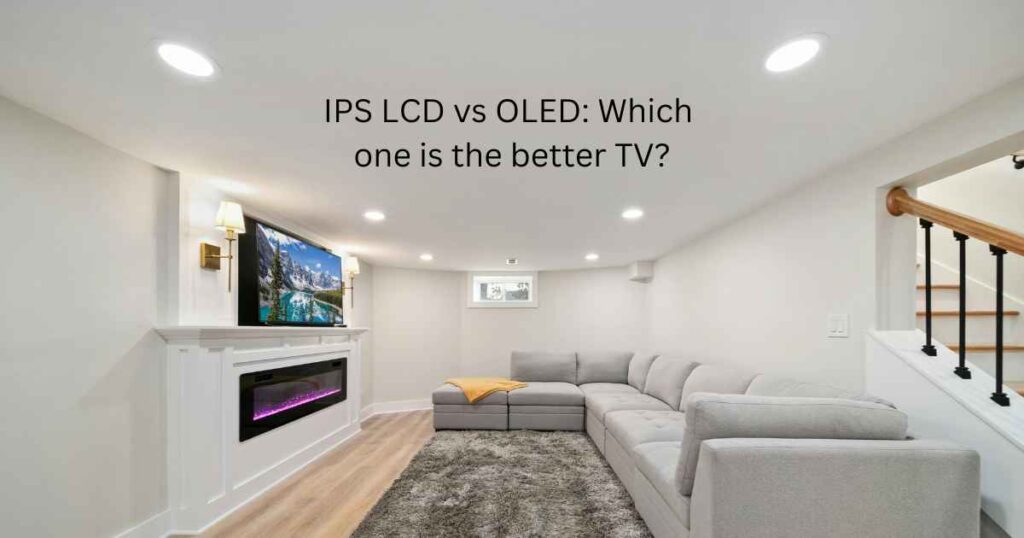Pixel Perfect or Budget Bliss? IPS LCD vs OLED TVs.

Some folks argue that IPS displays are better for gaming and offer more accurate colors, while others believe OLED panels provide superior black levels.
So, which one is the better overall choice out of IPS and OLED displays?
We’ll explore that in this article.
But first, let’s understand what IPS and OLED displays actually mean.
IPS LCD TV
IPS, which stands for “In-Plane Switching” is a type of panel used in LED-backlit LCD TVs.
The term refers to the specific arrangement of liquid crystals inside the panel.
In IPS displays, the liquid crystals are aligned in a horizontal plane in their original state.
They function like blinds or curtains that either block or allow light from the backlight to pass through to the screen.
Now, when activated by current, they show movement within the same horizontal plane, hence the name “In-Plane Switching” (IPS).
This allows the crystals to control the amount of light passing through from the LED backlight based on the image being displayed on the screen.
Because of their horizontal movement, IPS panels distribute light more evenly, resulting in wider viewing angles.
However, unlike VA (Vertical Alignment) panel’s vertically oriented crystals, IPS display’s crystals don’t block backlight as effectively due to their horizontal orientation.
As a result, IPS displays struggle to produce deep blacks and have lower contrast ratios, trading off contrast for improved viewing angles.
OLED TV
OLED, short for “Organic-Light Emitting Diode”, refers to a display technology where each pixel is composed of organic material that generates its own light and can switch on or off independently.
This allows OLED screens to achieve perfect black levels and outstanding contrast, as individual pixels can be completely turned off.
The self-lighting nature of OLED also results in very wide viewing angles, with consistent color accuracy even from the sides.
Unlike IPS or VA LCD panels, OLEDs don’t need a separate backlight since each pixel acts as its own light source.
IPS vs OLED
Now that we’ve covered the basics of IPS and OLED displays, let’s move on to a detailed comparison between the two.
In the end, we’ll draw a conclusion to determine which display type, IPS or OLED, is the better choice for purchase.
Contrast and Blacks
A standard IPS LCD TV without local dimming tends to display blacks that appear more grayish and has a lower contrast ratio.
However, models equipped with full-array local dimming, such as NanoCell TVs show better contrast than basic IPS LCDs.
IPS panels that utilize extremely small LEDs in their backlighting, like those found in QNED TVs, offer even greater contrast improvements over standard IPS displays.
Despite these enhancements, their contrast and black levels still fall far short of what OLED TVs deliver.
Watching content on an OLED TV in a dark or dim room is truly breathtaking.
This is because OLEDs don’t suffer from blooming, whereas IPS displays, even with advanced local dimming often exhibit light leakage from bright areas into darker regions, which reduces overall contrast.
This happens because IPS TVs have a limited number of dimming zones and use a backlight that stays on, making it almost impossible to achieve true black.
In contrast, OLED pixels can turn off completely, eliminating the blooming issue entirely.
Color Gamut and Accuracy
Almost all OLED TVs are capable of producing a wide color gamut, as each individual pixel can emit its own light and color.
This results in the reproduction of highly accurate colors on the screen that remain consistent even when viewed from extreme angles.
That said, IPS displays with advanced local dimming can also achieve a wide color gamut.
IPS LCD TVs like QNED and NanoCell, which use a nanoparticle layer to filter out dull colors, offer better color accuracy and wider color gamut compared to standard IPS panels.
However, when stacked against OLEDs, they generally fall behind.
Brightness and Color Volume
IPS displays, being LCD-based, are capable of reaching high brightness levels, making them very effective at reducing glare in bright environments, though this often comes at the expense of contrast.
IPS panels with mini-LED backlighting can offer both high brightness and a wide color gamut, resulting in excellent color volume, sometimes even surpassing that of many OLEDs.
This is because OLEDs typically have lower peak brightness, as pushing their organic pixels too hard can lead to faster degradation.
However, newer OLED technologies like QD-OLED (Quantum Dot-OLED) and MLA (Micro-Lens Array) based OLEDs have significantly improved brightness levels and can now achieve even higher color volume.
Additionally, OLEDs generally outperform IPS displays when it comes to managing reflections in bright rooms.
That said, high-quality IPS displays can still get brighter than many OLEDs in SDR content and handle reflections reasonably well, although they usually fall short in delivering deep black levels.
HDR Performance
OLED displays generally have superior reflection handling, a wider color gamut, and significantly better contrast and black levels compared to IPS panels.
This allows them to present HDR content with greater accuracy, highlighting bright elements against deep black backgrounds without any blooming.
However, IPS LCD TVs equipped with quantum dots and mini-LED backlighting can still deliver impressive HDR performance thanks to their high peak brightness and enhanced color volume.
Despite this, OLEDs maintain an edge in HDR due to their inherently higher contrast.
Additionally, while IPS displays can appear bright in SDR, they often fall short in achieving the same brightness in HDR mode.
Overall, OLEDs, especially QD-OLEDs and MLA-based WOLEDs with higher peak brightness offer one of the best HDR viewing experiences.
Viewing Angles
It’s now well understood that OLEDs offer significantly wider viewing angles than IPS LCDs, thanks to their self-emissive pixel technology.
While IPS LCD TVs do provide better viewing angles compared to standard LCDs and VA panels, they still lag behind OLEDs in this regard.
Response Time
OLED TV pixels emit their own light and can switch colors nearly instantly, leading to extremely fast response times.
This helps eliminate motion blur during fast-moving gaming scenes.
In contrast, IPS LCD TVs experience a delay because the backlight has to pass through multiple LCD layers before reaching the screen, which can cause motion blur or tearing during rapid action sequences.
Gaming
For fast and responsive gaming, whether on an IPS LCD or an OLED TV, several factors beyond just response time matter too.
The overall display delay includes response time, input lag, and refresh rate.
Input lag is influenced by delays from devices like the gaming console, keyboard, and cables.
Regarding refresh rates, both OLED and IPS screens can support up to 240 Hz or even higher.
However, the total display delay time can’t be judged solely by looking at the display.
Nowadays, both OLED and IPS panels provide low input lag and highly responsive gaming experiences.
That said, QD-OLEDs are probably the best TVs for gaming thanks to their vibrant, accurate colors and extremely fast response times, while IPS LCD TVs like QNEDs offer a more budget-friendly option with good color accuracy and low input lag.
Lifespan
Burn-in is an issue that can affect OLED TVs if a static image, like a channel logo, remains on the screen for an extended period.
This causes the image to appear as a faint ghost-like shadow, which may be temporary (called image retention) or permanent (known as burn-in).
However, with informed uses like watching varied content by changing channels at regular intervals, burn-in is not a major problem for OLED TVs.
That being said, IPS LCD TVs, which use inorganic pixels, are highly resistant to burn-in naturally.
OLED vs IPS LCD: Which Screen Reigns Supreme?
When comparing both types of TVs, we find that OLEDs mostly outperform IPS-based LCD TVs.
OLEDs provide wider viewing angles, superior contrast, better handling of reflections, more accurate colors, and minimal motion blur, resulting in much improved HDR performance compared to IPS displays.
Among OLEDs, QD-OLEDs offer enhanced color volume, making highlights stand out more, while MLA-based WOLEDs produce pure whites and can reach high brightness levels to effectively combat glare.
However, these premium OLED models tend to cost twice or even more than twice of standard IPS LCD TVs.
That said, for those on a tighter budget, IPS LCD TVs with good local dimming still deliver decent viewing angles, contrast, and brightness, providing a satisfactory viewing experience in brightly lit environments.
It’s also worth noting that in bright rooms, some OLEDs experience a slight rise in black levels.
So, often you might not get to experience the perfect blacks on OLEDs because their true strength shines in dark or dimly lit environments.
In bright rooms, MLA-based WOLEDs effectively combat glare while still maintaining deep black levels, but come with a high price tag.
If you’re looking for a more budget-friendly option, an IPS TV with a mini-LED backlight can offer high brightness, good colors, wide viewing angles, and decent contrast without significantly compromising the overall picture quality.
This is a good choice if you’re willing to sacrifice a bit of picture quality to save money.
That said, if you have control over your room’s lighting, OLED is always the better choice.
While IPS panels can reproduce bright highlights well, they often struggle with dark details because of their lower contrast.
On the opposite, OLEDs reveal clear shadow details and every subtle nuance in dark scenes.
Conclusion
As always, the decision between an IPS or OLED display will ultimately depend on your budget, preferences, and viewing environment.
For watching and gaming in dark to moderately lit rooms, any OLED TV is the superior option, offering accurate colors, fast response times, and true blacks that reveal both bright and dark details clearly.
QD-OLEDs, in particular, are the best choice for dark rooms thanks to their high color volume and vibrant details.
However, their black levels can rise in bright rooms, where MLA-based WOLEDs perform better by maintaining deep blacks.
In well-lit environments, IPS displays with good local dimming features, such as QNEDs and NanoCells are more affordable choices.


